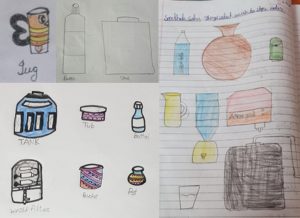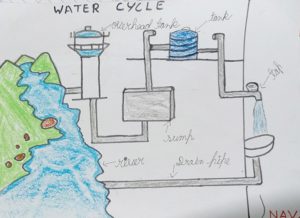While teaching about Water, its diverse uses, and the challenges facing us, Water Audit seemed a natural activity to pursue.
The children needed to find out the different activities at home that need water, and how the water was used. Next they needed to find out how much water each family member used. This included water used in the toilet, from brushing to bathing, or water for drinking. Then there was common usage of water – for cooking, washing, or gardening. The children measured all such use and determined the sum of all water used in the house. This gave them an opportunity to reflect in which activities maximum water was being used (washing machine is an example) – and how water usage can be reduced.
Pictures: Students drew the different ways water is stored in the house.
The challenge was also in how to measure, and that was interesting. How much water is needed for cooking and how much every time you flush the toilet? One common way students explored was to measure the water in pots or buckets in terms of water bottles of one litre volume. Estimating a fair approximation through measuring dimensions and calculating volume was more difficult.
After the Water Audit, and while discussing the need to save water, we discussed the Water Cycle.
The water cycle discussion was triggered with the question: how/where do you get your water? It comes from the tap. How does water come to the tap? It comes from the overhead tank. Where does that tank get water from? And so on, till they get to the clouds! Everyone drew the cycle the way they understood they get their water.
The water discussion was completed with the task of creating the Water Dictionary – recording and enhancing the student’s vocabulary of all water related words.


